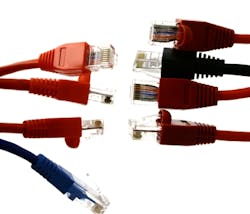A deep dive into TSB-184-A recommendations on cabling for PoE
On the heels of our recent reporting about a blog post from Belden’s Ron Tellas, we learned that Siemon’s Standards Informant provides detail on some of the elements of TIA’s TSB-184-A document. Authored by the company’s global sales engineer Valerie Maguire, a member of the TIA TR-42.7 Subcommittee, the blog entry (read it here) opens by explaining, “A wide range of safety extra low voltage (SELV) limited power source (LPS) applications may be supported using remote power deployed over balanced twisted-pair cabling. Examples of these types of applications include LAN devices supported by IEEE Std 802.3 PoE (DTE Power via MDI), wireless access points, TIA-862-B building automation systems, PoE lighting, and security devices such as remote cameras, IP telephones, and multimedia devices.”
TIA-184-A Guidelines for Supporting Power Delivery Over Twisted-Pair Cabling was published in March. “This Telecommunications Systems Bulletin provides guidelines to enable the support of a wide range of SELV LPS applications using remote power supplied over balanced twisted-pair cabling,” the post continues. “This TSB also describes methods to help manage temperature rise within cable bundles due to dissipation of power.”
TSB-184-A incorporates several significant changes from the previous TSB-184 document, the Standards Informant points out. In particular, the maximum applicable current has been increased to 1000 mA per pair, temperature rise models have been refined to include additional cable properties and installation conditions, temperature rise tables include temperature rise in open air and sealed conduit, bundling and installation recommendations have been added, measurement procedures to develop temperature rise models have been refined and included, and additional specifications for pair-to-pair DC resistance have been added.
Maguire’s post provides detail on the cabling recommend in TSB-148-A, as follows.
- Category 6A or higher performing 4-pair balanced twisted-pair cabling is recommended for new installations delivering remote power
- Thermal dissipation can be improved by selecting cables with:
- Improved thermal conductivity
- Improved heat transfer coefficient between cable materials
- Improved heat transfer coefficient between cable jacket and air
- Metallic elements (e.g. shield, screen)
- A larger diameter
- Connecting hardware having the required performance for mating and unmating under the relevant levels of electrical power and load (e.g. compliant to the test schedule described in IEC 60512-99-002 for engaging and separating connectors under electrical load) should be chosen
The TSB also includes bundling recommendations, which the blog entry discusses as well.
In an article we published in April 2014, Valerie Maguire discussed the use of shielded cabling for applications that employ remote powering. In the article’s conclusion, she stated, “All trends indicate that four-pair power delivery is the future of remote-powering technology. As the market for remotely powered IP devices grows and more-advanced powering technology is developed, the ability of cables and connectors to operate in higher-temperature environments and perform under DC load conditions will emerge as critical factors in the long-term reliability of cabling infrastructure used to support PoE and other low-voltage applications that deliver power over twisted pairs.”
